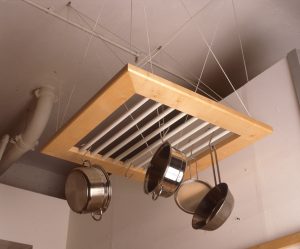Pan Rack, kitchen accessory range by Mark Lewis as Design Director Lewis & Horning (1983-87)
Mark first discovered the weaving mechanism for hanging a structure from a ceiling using rope years earlier. Cord is threaded through fixed steel eyes in the four corners of a frame and corresponding fixings in the ceiling. A cat’s cradle like configuration is woven by threading a single length of cord up down and across, vertically and diagonally until every possible plane is traversed, having fixed the start end to one eye bolt, and concluding by tying the final end, once the desired height for the frame has been determined.
The miraculous consequence of this is that the weight of the rack, although not insignificant, combines with the friction on the cord and the tension from one diagonal to the other to affect a completely rigid structure devoid of flexion or swing. It’s as if the frame were solid, invisibly bolted in place.
The simple version shown, made of solid maple with integral enameled hanging bars from which butchers hooks can be hung to take the pans and utensils was the first of the overhead racks and extractor housing designs made and displayed as part of a comprehensive range of kitchen accessories exclusive to L&H.

